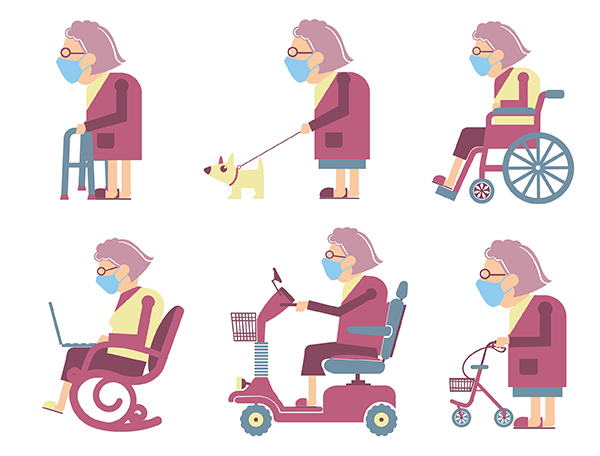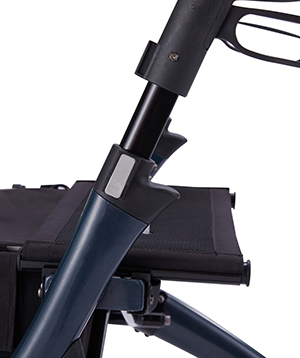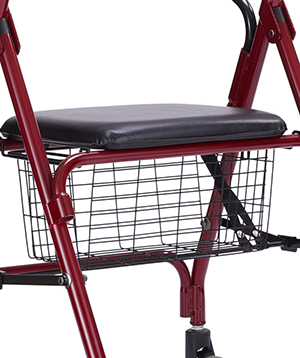Apr. 28, 2021
The COVID-19 pandemic limits many patients to receive standard health services, resulting in the increasing incidence of chronic disease, treatment delay, poor nursing care service, and prolonged recovery time. It raises the demand for walking aids from the aging and handicapped populations with arthritis, Parkinson’s, trauma, etc. Both the walker and rollator belong to walking aids, and please review below five points you need to know:

1. Brake
The rollator has a running brake function so that the user can stop the rollator at any time, and with the help of the parking brake function, the user can get up by supporting the rollator. There are different braking systems available on rollator but none on walkers.
A. Loop-lock brakes
It is the most common brake mechanism equipped on the rollator and much likes bicycle-style brakes. Pull up the brake lever to slow the rollator down or to stop temporarily. Push down the brake lever to lock the rollator and lean on the rollator to get reliable balance support. There are three kinds of brake levers: closed-loop brake lever, open-loop brake lever, and semi-loop brake lever.
Available on:
B. Push-down brakes
If it is too difficult for the user to squeeze the hand brake and frequently forget to use the loop-lock brakes, push-down brakes may be a good option. The user leans on the handle with downward pressure to activate the brake and stop moving.
Available on:
C. Bar brakes
The user could squeeze the brake bar by one hand only to slow down the rollator. This kind of brake bar is always long with a full length across the rollator, allowing the user for an easy random break.
Available on:
2. Wheels
There are no wheels attached to the standard walker so that the user should lift the walker to move forward. People could convert a standard walker into a wheeled walker with two 4.5” front wheels or 5” front wheels to help to maneuver over the surface. The four-wheel rollator always has two swivel front wheels and two direction-fixed rear wheels, easy to move without lifting the rollator. The wheel size attached on the indoor rollator is usually 6”, which is different from 8” wheels on the outdoor rollator. There are different materials of wheels, such as PVC, PU, EVA, etc.
Available on:
3. Seat
The rollator always has a built-in seat, which is very helpful for most users. When the user wants to go for a longer walker, although they have weakened endurance, they could take a break and sit when they want to. Once they have any breathing problems suddenly or other health issues, they could relax on the seat and prevent instant falling. There is no need to look around and find a clean place to sit, which is time-consuming with a strained heart. It is an important feature and helps the user to maintain and even prolong their mobility. The users can choose different kinds of seats such as padded seat, seat with EVA cover, mesh seat, etc. However, there is no seat equipped on the standard walker.


4. Mechanism
We could find different folding mechanisms such as paddle folding, lever folding, one-touch folding, two-button dual-release folding equipped on walkers, and non-folding walkers, which is very economical. The folding size of the walker is much smaller than the rollator. Thanks to the design of the folding mechanism, our mobility aids could be folded and fit into a vehicle.
The user needs to pull up the seat handle and fold the rollator side to side for some euro-style rollators. If the user prefers a compact packing size, they could choose a double folding rollator. There is also a folding front to back rollator, some with a plastic built-in handle, the user could hold seat handle to pull up, and then fold the frame, and the other with the black cord under the seat which needs the user to lift the seat first, and then pull the cord to fold the rollator.
The mechanism on the rollator is more compact than that on the walker when it comes with a series of accessories, such as the armrest to walk uprightly, electronics including laser light and powered driver, umbrella holder, cane holder, etc., to meet different people’s needs.
5. Price
Because the rollator has many more advanced functions than the walker, the rollator’s price is higher than that of the walker typically.
Conclusion
We expect the international walking aids market to continue to grow in the future as the seniors, especially those with chronic disease, need better and better care. Our product range is comprehensive and complete, whether our consumer wants a walker or a rollator, you could find the suitable one from us. Contact us for more information.